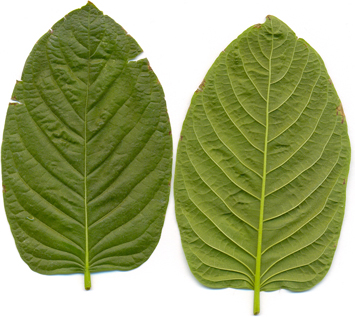 MEDIA ROOTS — Known mostly in parts of south east Asia and Thailand, kratom is somewhat of a cultural intoxicant similar to the use of coca leaves (from which cocaine is derived) by the Bolivians and the use of khat or betel nut used by Arabic cultures. The difference among these ‘cultural intoxicants’ is that kratom has effects similar to big pharma’s slew of ‘pain killer’ drugs. The term ‘pain killer’ here is a slight misnomer since drugs like Vicodin, OxyContin, codeine and morphine ‘kill’ pain by flooding the brain with pleasure, thus, distracting you from the physical pain you may be experiencing.
MEDIA ROOTS — Known mostly in parts of south east Asia and Thailand, kratom is somewhat of a cultural intoxicant similar to the use of coca leaves (from which cocaine is derived) by the Bolivians and the use of khat or betel nut used by Arabic cultures. The difference among these ‘cultural intoxicants’ is that kratom has effects similar to big pharma’s slew of ‘pain killer’ drugs. The term ‘pain killer’ here is a slight misnomer since drugs like Vicodin, OxyContin, codeine and morphine ‘kill’ pain by flooding the brain with pleasure, thus, distracting you from the physical pain you may be experiencing.
This may be hard to believe in today’s society, but pharmaceutical companies used to manufacture heroin. Before it was illegal, heroin was sold by Bayer as a way to ween oneself off of morphine addiction. Morphine itself was prescribed as a cough syrup. A much less potent opiate cough syrup common today is a mixture of codeine and promethazine (a sedative), referred to by rap culture as ‘purple drank.’
Presently, pharmaceutical companies rake in big money from sales of highly addictive narcotic ‘pain killers,’ such as OxyContin. OxyContin, in and of itself, is equally as addictive as pure heroin (since heroin sold on the streets is usually not pure, especially that sold on the west coast; by all accounts, OxyContin is actually a more addictive drug than most street heroin). Pharmaceutical companies have even gone so far as synthesizing new opiate drugs that are far more potent and addictive than even heroin, OxyContin, or morphine. They come in highly concentrated forms like Fentanyl or Dilaudid. Unbelievably, Fentanyl, a drug ten times more potent than heroin, can be prescribed in the form of lickable lollipop candy, as well as patches to put on the arm for a long-term timed-release ‘pain killing‘ effect.
It seems pharmaceutical companies would rather have a society addicted on their expensive pain pills than see someone medicate using a legal, less addictive and, in some cases, equally as effective, natural pain killer, such as kratom. Now that kratom has ‘taken off’ via internet sales and it is still legal in most areas of the world, the US government, under Obama, is trying to crack down and make it unobtainable by the public.
Robbie Martin
***
THE STRANGER — Kratom was first documented as an opiate substitute—a kind of herbal methadone—in Asia in the early 1800s. It’s often used by people who want an alternative to opiates, either because they’re trying to break an addiction or because they want some way to manage chronic pain without opiate-based drugs.
Every few months, a new intoxicant that isn’t technically covered by US drug-prohibition laws pops up on the market and policymakers, acting on very little information, freak out over it. Unfortunately for kratom, it has appeared in the immediate wake of the “bath salts” hysteria. (The hysteria was not entirely unjustified, as the active ingredient of “bath salts,” a chemical called MDPV, was held responsible for long-term psychiatric damage and several deaths.) Kratom is already in the early stages of the same cycle.
That cycle goes like this: Clever entrepreneurs find an intoxicant not covered under current law and begin selling it. People get excited about it and chatter online. Some user winds up in the emergency room—for reasons that may or may not be serious—and says its name to a doctor who’s never heard of it. The doctor calls the poison control center, and the public-health bureaucracy scrambles to figure out what this exotic new drug is. Someone talks to a reporter, and soon newspapers and TV stations are all over it, breathlessly warning parents about a “dangerous new high” threatening their children. Lawmakers see a chance to score some points by being tough on drugs and ban it. The drug fades away. A clever new entrepreneur finds a new drug, and the whack-a-mole cycle begins again.
Enter kratom, stage right.
Read more about The Rush To Prohibit Kratom.
© 2012 The Stranger
***
Photo by Wikimedia Commons user Abalg











Bureaucrats should not medal in areas where they have no experience or expertise. It is now time to through the lobbyist out of government.